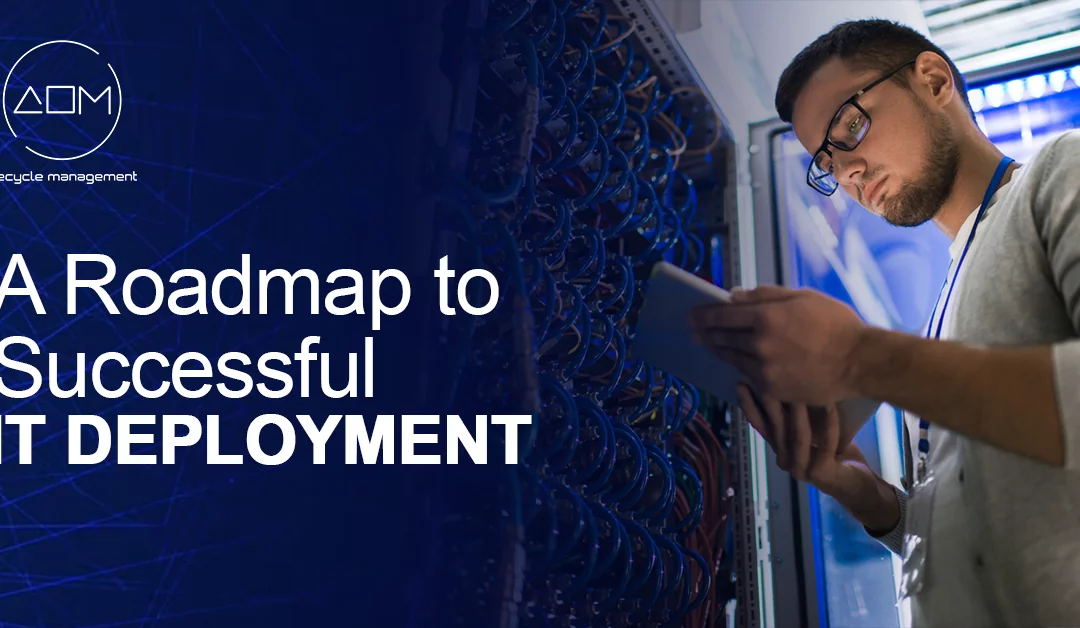In the digital age, Information Technology (IT) is the backbone of any successful business. With the support of reliable hardware maintenance services and IT equipment support, organizations can ensure seamless transitions, minimize downtime, and maximize productivity. The deployment of new IT systems, whether software, hardware, or networks, is a critical task that requires careful planning and execution.

A smooth and successful IT deployment can enhance productivity, reduce operational costs, and improve customer satisfaction. Here is a step-by-step guide to ensure a successful IT deployment.
1. Define Clear Objectives
Before embarking on any IT deployment, it’s crucial to clearly define what you hope to achieve. This might be improving operational efficiency, streamlining processes, or enhancing security. Clear objectives will help guide decision-making throughout the process and provide a benchmark for success.

2. Assemble a Dedicated Team
Assemble a team of experienced and competent individuals who can take responsibility for different aspects of the deployment. This team should comprise IT professionals, end users, and possibly external consultants. Each team member should understand their role and responsibilities in the deployment process.
3. Prioritize Mission-Critical Tasks
Not all tasks in an IT deployment have the same level of importance. It is essential to identify and prioritize mission-critical tasks to ensure that they are addressed first and receive the necessary resources and attention.
4. Manage Resources Efficiently
Effective resource management is crucial for smooth IT deployment. This includes managing both human and technical resources. For instance, field engineers need to know how to handle data center dismantling, moves, and reconnects while delivering consistent, secure, and on-time results.

5. Comprehensive Planning
Planning is crucial to successful IT deployment. This phase should include a detailed project timeline, budgeting, risk assessment, and contingency planning. The plan should also consider training for end users and post-deployment support. Additionally, organizations can leverage IT asset management services to track and optimize their hardware resources, ensuring a streamlined and cost-effective deployment.
6. Vendor Evaluation and Selection
If your deployment involves procuring new technology, it’s important to carefully evaluate potential vendors. Consider factors like cost, product features, vendor reputation, support, and compatibility with your existing systems. Once you’ve selected a vendor, make sure to negotiate a detailed contract that includes terms for service and support.
7. Testing
Before fully deploying a new system, it’s essential to conduct thorough testing. This can help identify any potential issues or flaws that could cause problems down the line. Testing should be conducted in a controlled environment and should simulate real-world usage as closely as possible.

8. Training and Documentation
A new system is only as good as the people who use it. Ensure that all end users receive thorough training on the new system, and that comprehensive documentation is available for reference. This can help reduce resistance to the new system and ensure that it’s used effectively and efficiently.
9. Phased Rollout
Instead of deploying the new system all at once, consider a phased rollout. This means implementing the new system in stages, starting with a small group of users or a single department. This allows you to identify and address any issues before rolling out the system to the entire organization.
10. Post-deployment Support and Evaluation
After the new system is deployed, it’s important to provide ongoing support to end users and to regularly evaluate the system’s performance. This can help you identify any issues or areas for improvement, and ensure that the new system is meeting its intended objectives.
How Can AOM Help?
To add further context and specific information related to IT deployment, it’s important to highlight the offerings of AOM, a trusted partner with a successful record in IT deployment, relocation, and testing. They provide end-to-end relocations, including consultations, project management, secure transportation, de-install, and reinstall services.

Navigating Complexity with Expertise: AOM’s Field Engineers in Action
AOM’s field engineers are adept at handling data center dismantling, moves, and reconnects, ensuring consistent, secure, and on-time results. This involves dealing with a range of hardware components such as servers and switches, de-racking/re-racking, managing wires and cables, cable mapping, elevation execution, white glove packing, and secure transport.
Maximizing Efficiency & Minimizing Risks: AOM’s Seamless Network Equipment Moving Solutions
AOM presents a comprehensive solution for moving network equipment, servers, racks, and cabinets from one location to another. They ensure minimum IT downtime with coordinated scheduling and timelines, prioritization of mission-critical tasks, and flexible scheduling and security measures.
Their services also include:
- Protection Against Risk And Damage
- Onsite Project Management
- Constant Communication
- Planned Scope And Pre-Execution Walk-Through
- Secured Assets From Disconnect To Disposition Or Relocation
They maintain complete documentation, including chain of custody and asset transfer forms, and manage packing and transport for immediate power-up, storage, redeployment, remarketing, or recycling.
From Planning to Perfection: AOM’s Unparalleled Approach to Secure IT Relocation
With a partner like AOM, organizations can feel confident that their IT deployment and relocation will be handled efficiently and securely, minimizing potential complications and surprises. AOM’s approach underscores the importance of comprehensive planning, skilled execution, and continual communication in ensuring a smooth and successful IT deployment.
Wrapping Up
In conclusion, a successful IT deployment requires a comprehensive plan, efficient resource management, prioritization of critical tasks, robust security measures, and effective communication. By following these steps, you can ensure a smooth and successful IT deployment.
A successful IT deployment can bring significant benefits to an organization, but it’s not a task to be undertaken lightly. With careful planning, a dedicated team, thorough testing, and ongoing support, you can ensure a smooth and successful deployment that meets your organization’s needs and objectives. Remember, the goal is not just to deploy a new system, but to enhance your organization’s capabilities and deliver long-term value.

